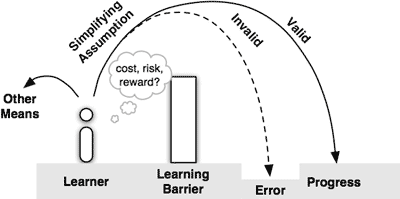

| Home | Motivation | Studies | The Whyline | Funding | Publications | Contact |
Studies and Findings
Understanding DebuggingMost of our studies have focused on programmers new to Alice, and specifically on tasks of creating highly interactive, state-based games such as Pac-Man. We have developed a framework and methodology for studying the causes of software errors, and have applied it to Alice. In our observations, we have found that a significant proportion of the errors are ultimately caused by a viscious cycle of assumptions: programmers introduced an error, which caused their programs to fail; when debugging the failure, they incorrectly assumed that one aspect of their code was to blame, and made modifications to try to fix it, introducing more errors. When these errors were debugged, programmers again made false assumptions about their code, and the cycle continued. In general, these false assumptions were the cause of half of the errors that programmers later introduced. The WhylineOur goal in designing a solution was to prevent the false assumptions that programmers were making about what did or did not happen at runtime. Our rationale was that if we prevent them from ever making an assumption about what happened at runtime, then they cannot make an incorrect assumption. And to prevent someone from making an assumption, you have them ask questions. Thus, we analyzed programmers questions at the time of program failure and found that they were of two forms: Why did questions, which presumed some runtime action, and Why didn't questions, which questioned the absence of some runtime action. As it turns out, there are three possible answers to these two questions:
From these observations, we designed and implemented the Whyline (a Workspace for Helping You Link Instructions to Numbers and Events). See a demo on the tools page! Learning Barriers in Programming SystemsPrior research on learning barriers in programming systems has primarily focused on programming languages, overlooking potential learning barriers in the environment and accompanying libraries. To address this, we performed a study of beginning programmers learning Visual Basic.NET in order to develop a categorization of learning barriers. What are Learning Barriers?One way to understand learning barriers is to study the learner. For example, imagine Jill, a user interface designer who just began learning VB. Shortly after starting, she realizes that she must learn about event handlers to proceed. This poses a potential learning barrier. From an attention-investment perspective, she will weigh the cost, risk, and reward of overcoming the barrier, and if the risk of failure outweighs the reward, she may abandon VB for other tools. Jill may also decide that progress is worth the risk of failure. We have proposed a framework describing the causes of software errors that suggests she will make several simplifying assumptions about the language, environment, and libraries in trying to acquire the necessary knowledge. If her assumptions are valid with respect to the programming system, she will make progress. If her assumptions invalid with respect to VB—what we call knowledge breakdowns—she is likely to make an error. Within this framework, we define learning barriers as aspects of a programming system or programming problem that are prone to such invalid assumptions. These concepts and their relationships are depicted below. Given these definitions, what aspects of programming systems might pose learning barriers? Research has explicitly identified several aspects of programming languages that are prone to invalid assumptions, including conditionals, Boolean operators, loops and data structures. Others have found that the task-specificity of language constructs influencess learners'assumptions. There has been little research, however, on barriers in the rest of the programming system. Six Learning Barriers in End-User Programming SystemsOur study identified six types of learning barriers: design, selection, coordination, use, understanding, and information barriers.
Studying Expert Use of the Eclipse IDE for JavaWe have just completed a study for dozens of expert programmers using the Eclipse IDE to test, debug, and augment a Swing application. We'll have results soon! |
|||||||
|
